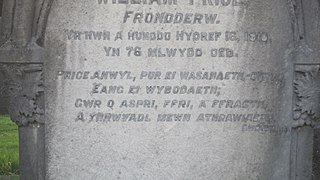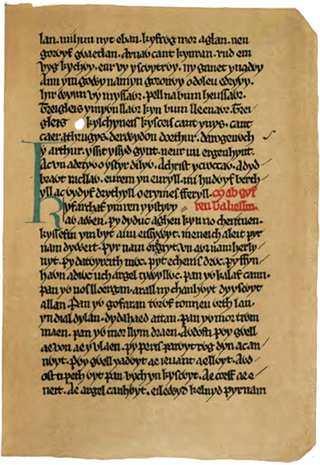Related Research Articles
Taliesin was an early Brittonic poet of Sub-Roman Britain whose work has possibly survived in a Middle Welsh manuscript, the Book of Taliesin. Taliesin was a renowned bard who is believed to have sung at the courts of at least three kings.

Englyn is a traditional Welsh and Cornish short poem form. It uses quantitative metres, involving the counting of syllables, and rigid patterns of rhyme and half rhyme. Each line contains a repeating pattern of consonants and accent known as cynghanedd.

Baschurch is a large village and civil parish in Shropshire, England. It lies in the north of Shropshire. The village had a population of 2,503 as of the 2011 census. Shrewsbury is to the south-east, Oswestry is to the north-west, and Wem is to the north-east of Baschurch. The village is also close to Ruyton-XI-Towns.

The Red Book of Hergest, Oxford, Jesus College, MS 111, is a large vellum manuscript written shortly after 1382, which ranks as one of the most important medieval manuscripts written in the Welsh language. It preserves a collection of Welsh prose and poetry, notably the tales of the Mabinogion and Gogynfeirdd poetry. The manuscript derives its name from the colour of its leather binding and from its association with Hergest Court between the late 15th and early 17th century.

The Book of Taliesin is one of the most famous of Middle Welsh manuscripts, dating from the first half of the 14th century though many of the fifty-six poems it preserves are taken to originate in the 10th century or before.

Y Gododdin is a medieval Welsh poem consisting of a series of elegies to the men of the Brittonic kingdom of Gododdin and its allies who, according to the conventional interpretation, died fighting the Angles of Deira and Bernicia at a place named Catraeth in about AD 600. It is traditionally ascribed to the bard Aneirin and survives only in one manuscript, the "Book of Aneirin".
Medieval Welsh literature is the literature written in the Welsh language during the Middle Ages. This includes material starting from the 5th century AD, when Welsh was in the process of becoming distinct from Common Brittonic, and continuing to the works of the 16th century.

Sir John Rhŷs, was a Welsh scholar, fellow of the British Academy, Celticist and the first professor of Celtic at Oxford University.
Geraint son of Erbin is a medieval Welsh poem celebrating the hero Geraint and his deeds at the Battle of Llongborth. The poem consists of three-line englyn stanzas and exists in several versions all in Middle Welsh. The earliest surviving version is in the Black Book of Carmarthen, completed around 1250, though the poem may have been composed in the 10th or 11th century. The poem is significant for its early mention of King Arthur.
Llywarch Hen, was a prince and poet of the Brythonic kingdom of Rheged, a ruling family in the Hen Ogledd or "Old North" of Britain. Along with Taliesin, Aneirin, and Myrddin, he is held to be one of the four great bards of early Welsh poetry. Whether he actually wrote the poems attributed to him is unknown, and most of what is known about his life is derived from early medieval poems which may or may not be historically accurate.
Cynddylan, or Cynddylan ap Cyndrwyn was a seventh-century Prince of Powys associated with Pengwern. Cynddylan is attested only in literary sources: unlike many kings from Brittonic post-Roman Britain, he does not appear in the early Welsh genealogies or other historical sources. The son of King Cyndrwyn, Cynddylan is described in the probably seventh-century poem Marwnad Cynddylan and seems to have been a chieftain in Powys.
Cambrian Medieval Celtic Studies is a bi-annual academic journal of Celtic studies, which appears in summer and winter. The journal was founded as Cambridge Medieval Celtic Studies in 1981 by Patrick Sims-Williams, who has remained the journal's editor to this day. It was given its present title beginning with volume 26 in 1993.
The Englynion y Beddau is a Middle Welsh verse catalogue listing the resting places (beddau) of legendary heroes. It consists of a series of englynion, or short stanzas in quantitative meter, and survives in a number of manuscripts. The collection is thought to be considerably older than its earliest manuscript, the 13th-century Black Book of Carmarthen, and provides an important early glimpse at medieval Welsh heroic tradition and topographical folklore.
Englynion y Clywaid is a collection of Welsh stanzas.
Canu Llywarch Hen are a collection of early Welsh englyn-poems. They comprise the most famous of the early Welsh cycles of englynion about heroes of post-Roman North Britain.
Claf Abercuawg is the modern title of a 32-stanza medieval Welsh englyn-poem. According to Jenny Rowland, 'most critics would classify it among the most sophisticated and moving all the early englynion poems'; it is 'the classic example' of meditative, lyric, at least implicitly religious, early Welsh poetry.
Kyntaw geir is a medieval Welsh englyn-poem. It is a relatively rare example of religious poetry in the englyn form.
Canu Heledd are a collection of early Welsh englyn-poems. They are rare among medieval Welsh poems for being set in the mouth of a female character. One prominent figure in the poems is Heledd's dead brother Cynddylan.
Cyfeilliog was Bishop of Ergyng and probably Gwent in south-east Wales. He is recorded by the mid-880s in the Llandaff Charters and in 914 he was captured by the Vikings and ransomed by Edward the Elder, King of the Anglo-Saxons, for 40 pounds. He is probably the author of a cryptogram in the Juvencus Manuscript which would have required a knowledge of Latin and Greek.
References
- ↑ John T. Koch, 'The Juvencus Manuscript', in Celtic Culture: A Historical Encyclopedia, ed. by John T. Koch (Santa Barbara: ABC-CLIO, 2005), s.v.
- ↑ Helen McKee, 'Scribes and Glosses from Dark Age Wales: The Cambridge Juvencus Manuscript', CMCS, 39 (2000), 1-22.
- ↑ John T. Koch, 'The Juvencus Manuscript', in Celtic Culture: A Historical Encyclopedia, ed. by John T. Koch (Santa Barbara: ABC-CLIO, 2005), s.v.
- ↑ Myriah Williams, 'Cambridge Juvencus (MS Ff.4.42)', http://cudl.lib.cam.ac.uk/view/MS-FF-00004-00042.
- ↑ John T. Koch, 'The Juvencus Manuscript', in Celtic Culture: A Historical Encyclopedia, ed. by John T. Koch (Santa Barbara: ABC-CLIO, 2005), s.v.
- ↑ Jenny Rowland, Early Welsh Saga Poetry: A Study and Edition of the 'Englynion’ (Cambridge: Brewer, 1990), pp. 466-67, 510.
- ↑ Jenny Rowland, Early Welsh Saga Poetry: A Study and Edition of the 'Englynion’ (Cambridge: Brewer, 1990), p. 249.
- ↑ William Forbes Skene, The Four Ancient Books of Wales, 2 vols (Edinburgh: Edmonston and Douglas, 1868), II, 1-2, https://books.google.com/books?id=7uEIAAAAQAAJ 'Périodiques I', Revue Celtique, 51 (1934), 164-70 (p. 167), https://archive.org/details/revueceltique51pari.
- ↑ McKee, Helen (ed.), Juvencus Codex Cantabrigiensis Ff.4.42: llawysgrif o'r nawfed ganrif gyda glosau Cymraeg, Gwyddeleg, a Lladin (Aberystwyth: Cyhoeddiadau CMCS, 2000).